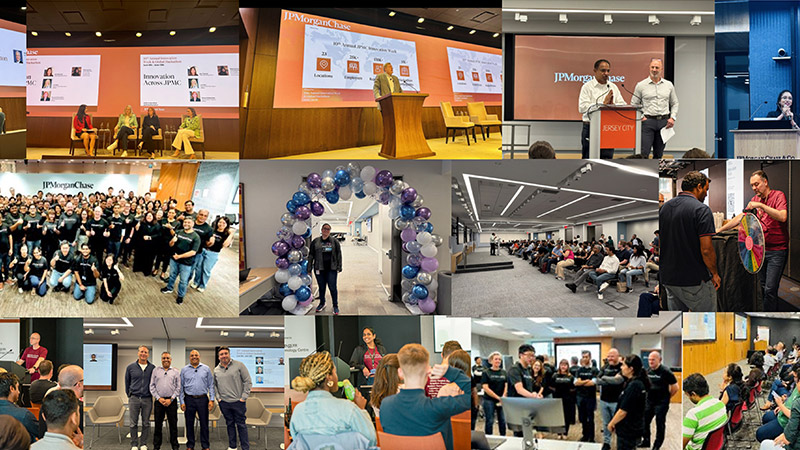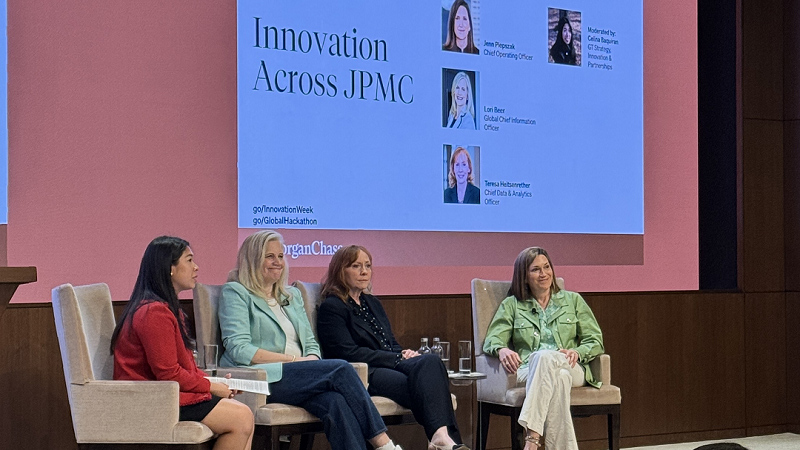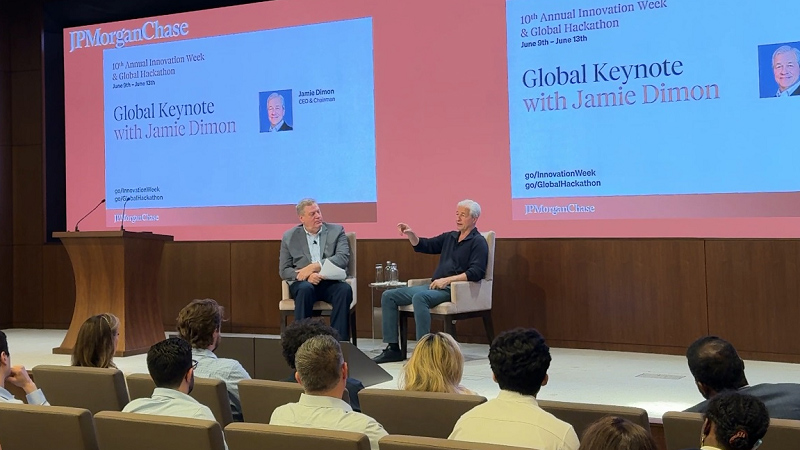
As the Global Technology Strategy, Innovation, and Partnerships Team, we study the tech landscape and bring insights from our industry engagements to influence our innovation strategy at JPMorganChase.
Earlier this year, we published our insights on the tech trends that would take over 2025 in our Emerging Tech Trends Report. During 10th Annual Innovation Week, we saw these insights play out in real time across JPMorganChase’s 23 Global Technology Centers. Through a series of keynotes and hundreds of local, hands-on sessions focusing on AI, cloud, cybersecurity, and more, Innovation Week offered a view into our strategic focus areas and the transformative power of innovation.
The rise of generative and agentic AI
In 2025, Innovation and AI go hand in hand. Our Chairman and CEO, Jamie Dimon, kicked off Innovation Week by sitting down with Larry Feinsmith, the head of our Global Technology Strategy, Innovation, and Partnerships team, to discuss the firm’s approach to innovation. He started off by highlighting how innovation has always been a catalyst for change. In his list of monumental societal innovations – agriculture, printing, steel, electricity, the internet, to name a few – AI is the latest.
AI was a key theme of the week, as our keynote speakers reinforced its transformative impact and technologists experimented with potential use cases in their teams and lines of business. The next frontier, GenAI and AI agents, were major focus areas.
In our report, we highlight the pivotal role of GenAI and AI agents in automating workflows and enhancing user experiences. Across the industry, GenAI has already expanded the efficiencies and capabilities of existing technologies. At JPMorganChase, GenAI is helping our software engineers become more efficient coders, yielding up to 20% more efficiencies in the software development lifecycle and helping our tech teams deliver more for our businesses.
On the agentic front, we are also seeing a proliferation of AI agents that can act more autonomously. “It comes up with a plan, it creates steps, it can go back and identify mistakes, replan, and ultimately give a final response,” Larry succinctly explained.
At the speed in which AI agents are evolving, we can see a transition from single-agent to multi-agent systems will have implications for how teams and workflows are structured. The concept of orchestration, how AI agents interact with each other and integrate into systems, is set to revolutionize operational frameworks.

Data and AI/ML at scale
Our Chief Operating Officer Jennifer Piepszak, Global Chief Information Officer Lori Beer and Chief Data & Analytics Officer Teresa Heitsenrether, came together to discuss how we’re innovating across the firm, signaling that there’s more to AI than just hype. With over 500 use cases in production, we’ve seen real impact from AI technologies, whether it's cost avoidance, risk reduction, or revenue growth.
LLM Suite, the firm’s in-house GenAI chatbot, was showcased as an example of the immense impact and adoption of innovation across our global organization. Since launching in 2024, the firm has expanded access to LLM Suite to 200,000 employees and continues to add new capabilities.
Technology isn’t new, but the pace of technological advancements is. Lori observed that the evolution timelines for tech providers offering new features have decreased from the span of three to five years to quarters.
Technology modernization
While saying AI is the cherry on top is an understatement, its effectiveness does rely on a deeply integrated tech stack that includes innovation happening at the infrastructure layer. To build innovative products and experiences, we have to prioritize modernizing our software development, leaning into the cloud and our data infrastructure.
During a discussion on emerging tech trends, Larry highlighted how GenAI is transforming the cloud and driving competition amongst providers who are racing to build storage capacity. As organizations continue to modernize, they leverage AI workload orchestration and agentic software development as key drivers. The rise of agentic platforms represents a shift in how software is being developed and deployed, reaffirming the symbiosis between cloud-based applications and AI capabilities.
Our team provided additional background on significant infrastructure investments being made to support AI capabilities across the industry, including the construction of data centers and advanced GPU offerings.
Protecting the firm
In discussion of how the firm balances innovation and security, we discussed the risks emerging technologies such as agentic AI can pose, and how we can innovate in service of a stronger cybersecurity ecosystem.
Leaders agreed that we cannot get too caught up in the noise surrounding AI. Instead, we must focus on building solutions that last, that can run with the speed of technology and the threat landscape. Teresa emphasized the importance of prioritizing proper guardrails before thinking about scaling technologies.
For example, our team discussed how in the wrong hands, AI can enhance the scale, speed, and believability of social engineering attacks. By implementing robust guardrails, we ensure secure interactions and data flows, safeguarding existing systems while embracing AI’s potential.
Leveraging emerging technology to strengthen our security measures is part of our goal of making clients, customers, and our employees’ lives better. Sometimes that can result in differentiation, standardization, or slowing down – not for too long, of course. Innovation is also saying no to a hundred ideas in service of getting the right ones to the pipeline.
“Time flies when you’re innovating”
Innovation is a fundamental cornerstone of JPMorganChase, embedded into every corner of our businesses, operations, and strategy. “Time flies when you're innovating,” as Larry puts it. For ten years, Innovation Week has celebrated and developed the ideas that lead to technological breakthroughs and drive our business forward.
As we continue to embrace the future of technology, Innovation Week reaffirms our commitment to pioneering advancements, fostering a culture of continuous learning, and shaping the industry landscape.
